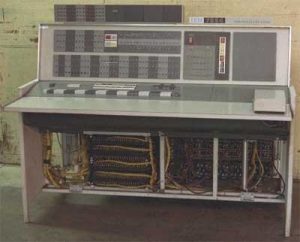Back to: COMPUTER SCIENCE JSS1
Welcome to class!
In today’s class, we will be talking about the generation of computers. Enjoy the class!
Generation of Computers

Generation in computer terminology is a change in technology a computer is/was being used. Initially, the generation term was used to distinguish between varying hardware technologies. Nowadays, generation includes both hardware and software, which together make up an entire computer system.
There are five computer generations known to date. Each generation has been discussed in detail along with their period and characteristics. In the following table, approximate dates against each generation have been mentioned, which are normally accepted.
Following are the main five generations of computers.
| S/No | Generation & Description
|
| 1 | First Generation The period of the first generation: 1946-1959. Vacuum tube-based.
|
| 2 | Second Generation The period of the second generation: 1959-1965. Transistor-based.
|
| 3 | Third Generation The period of the third generation: 1965-1971. Integrated Circuit based.
|
| 4 | Fourth Generation The period of fourth-generation: 1971-1980. VLSI microprocessor-based.
|
| 5 | Fifth Generation The period of fifth-generation: 1980-onwards. ULSI microprocessor-based.
|
First Generation:
The period of the first generation was from 1946-1959. The computers of first-generation used vacuum tubes as the basic components for memory and circuitry for CPU (Central Processing Unit). These tubes, like electric bulbs, produced a lot of heat and the installations used to fuse frequently. Therefore, they were very expensive and only large organizations were able to afford it.

The main features of the first generation
- Vacuum tube technology
- Unreliable
- Supported machine language only
- Very costly
- Generated a lot of heat
- Slow input and output devices
- Huge size
- Need for Air conditioning
- Non-portable
- Consumed a lot of electricity
Some computers of this generation
- ENIAC
- EDVAC
- UNIVAC
- IBM-701
- IBM-650
Second Generation:
The period of the second generation was from 1959-1965. In this generation, transistors were used that were cheaper, consumed less power, more compact, more reliable and faster than the first-generation machines made of vacuum tubes. In this generation, magnetic cores were used as the primary memory and magnetic tape and magnetic disks as secondary storage devices.

The main features of the second generation
- Use of transistors
- Reliable in comparison to first-generation computers
- Smaller size as compared to first-generation computers
- Generated less heat as compared to first-generation computers
- Consumed less electricity as compared to first-generation computers
- Faster than first-generation computers
- Still very costly
- Air conditioning required
- Supported machine and assembly languages
Some computers of this generation
- IBM 1620
- IBM 7094
- CDC 1604
- CDC 3600
- UNIVAC 1108
Third Generation:
The period of the third generation was from 1965-1971. The computers of the third generation used Integrated Circuits (ICs) in place of transistors. A single IC has many transistors, resistors, and capacitors along with the associated circuitry.

The main features of the third generation
- IC used
- More reliable in comparison to the previous two generations
- Smaller size
- Generated less heat
- Faster
- Lesser maintenance
- Costly
- AC required
- Consumed lesser electricity
- Supported high-level language
Some computers of this generation
- IBM-360 series
- Honeywell-6000 series
- PDP (Personal Data Processor)
- IBM-370/168
- TDC-316
Fourth Generation:
The period of the fourth generation was from 1971-1980. Computers of fourth-generation used Very Large Scale Integrated (VLSI) circuits. VLSI circuits having about 5000 transistors and other circuit elements with their associated circuits on a single chip made it possible to have microcomputers of the fourth generation.

The main features of the fourth generation
- VLSI technology used
- Very cheap
- Portable and reliable
- Use of PCs
- Very small size
- Pipeline processing
- No AC required
- Concept of the internet was introduced
- Great developments in the fields of networks
- Computers became easily available
Some computers of this generation
- DEC 10
- STAR 1000
- PDP 11
- CRAY-1(Super Computer)
- CRAY-X-MP (Super Computer)
Fifth Generation:
The period of fifth-generation is from 1980-till date. In the fifth generation, VLSI technology became ULSI (Ultra Large-Scale Integration) technology, resulting in the production of microprocessor chips having ten million electronic components.
This generation is based on parallel processing hardware and AI (Artificial Intelligence) software. AI is an emerging branch in computer science, which interprets the means and method of making computers think like human beings. All the high-level languages like C and C++, Java, .Net etc., are used in this generation.

AI includes:
- Robotics
- Neural Networks
- Game Playing
- Development of expert systems to make decisions in real-life situations
- Natural language understanding and generation
The main features of fifth-generation are:
- ULSI technology
- Development of true artificial intelligence
- Development of Natural language processing
- Advancement in Parallel Processing
- Advancement in Superconductor technology
- More user-friendly interfaces with multimedia features
- Availability of very powerful and compact computers at cheaper rates
Some computer types of this generation are:
- Desktop
- Laptop
- Notebook
- Ultra-book
- Chromebook
In our next class, we will be talking about Computer Concepts. We hope you enjoyed the class.
Should you have any further question, feel free to ask in the comment section below and trust us to respond as soon as possible.

I like this topic
We’re glad you found it helpful😊 For even more class notes, engaging videos, and homework assistance, just download our Mobile App at https://play.google.com/store/apps/details?id=com.afrilearn. It’s packed with resources to help you succeed🌟
no problem
I don’t see fouth generation computer picture 😳😳😳😳😳 why?
pls explain classification of computer (special purpose and general energy
Good morning and happy Sunday please kindly help with the name of this text book and references